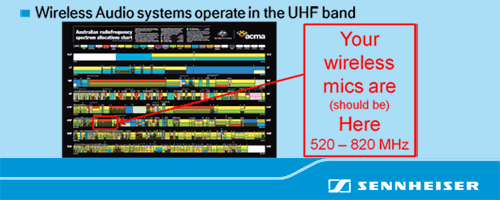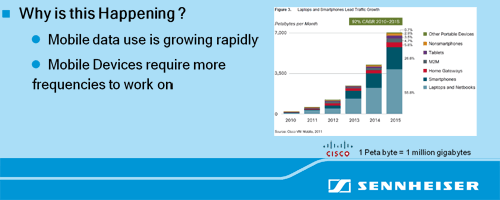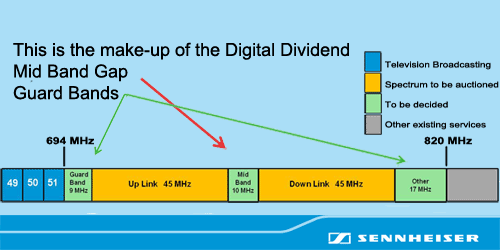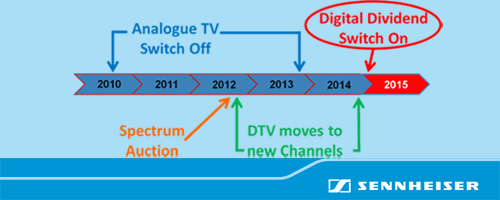Information courtesy of Syntec International
Wireless microphones and IEM systems currently operate as a "Secondary Service" in a band of UHF Frequencies between 520 MHz and 820 MHz. This band of frequencies is primarily used for Free To Air Television transmission.

Wireless mics and IEM systems operate as a Secondary Service under a Class Licence which permits them to be used on frequencies not licenced to a TV station in any particular area. It is illegal to operate a wireless audio system on a frequency licenced to a TV station in the same location.
Wireless audio systems operate on the frequencies between those used by the TV stations.
Digital Dividend is the term that is used to describe a band of frequencies between 694 MHz and 820 MHz. This frequency band is being cleared of existing users so that it can be used for mobile telecommunications in the future.
This application is being driven by the expected growth in the amount of mobile data traffic which is forecast for the coming years.

Growth of mobile data use is predicted at a rate of 92% year on year for each of the next 5 years, as shown in this graph which references data from Cisco.
The whole CISCO report can be accessed here
This extra mobile data traffic demands that more "bandwidth" is made available for it.
The clearing of the Digital Dividend and the sale of usage rights is happening across the globe. It has already happened in the USA and parts of Europe, and is in the process of happening in Australia and New Zealand.
In Australia the Federal government is planning to hold an auction for the usage rights to the Digital Dividend in the second half of 2012, with the "empty" Digital Dividend available from 1 January 2015 to those who are successful in that auction.
It has been reported that this auction could yield something of the order of AUD$2.5 billion.
Let's have a look at what is happening, why and when.
This shows the four stages which will be used to deliver a "clear" digital dividend.
It is diagrammatic only, to help illustrate the process. The actual situation is far more complex than it appears here.

Stage 1 shows how Analogue TV stations (yellow blocks) are spread across the range of frequencies between 520 MHz and 820 MHZ. Each station is 7 MHz wide, and because of technical reasons they cannot be allocated adjacent to each other. You can see gaps of unused spectrum (the blue areas) and it is on these frequencies that our existing wireless audio systems have been operating, between the TV stations.

Stage 2 shows the situation as Digital TV stations (the pink blocks) have been introduced. They are still spaced apart, between the existing analogue transmitters. The band has become more crowded, but there are still gaps in which wireless audio systems can work.
Most of the digital TV transmitters that will exist have been switched on by mid 2011.

Stage 3 sees the analogue TV transmitters being switched off, a process which is well underway. The analogue TV transmitters are being switched off on a region by region basis, with the first region being Mildura in North West Victoria switched off in October 2010. This process will continue until the end of 2013, when the major capital cities will have their analogue TV transmitters switched off.

Stage 4 is a process known as the "Restack". This is when the Digital TV transmitters will have their frequencies changed, with all of them moved to the band of frequencies between 520 MHz and 694 MHz These changes will also be made gradually, over a period of 2 years, starting in late 2012.
It is not only Digital TV transmitters that need to move out of the frequencies above 694 MHz. ALL wireless audio systems will need to vacate this band too, and operate only between 520 MHz and 694 MHz.
The area shown in red is the range of frequencies known as the Digital Dividend, and this is the range of frequencies from which all wireless audio systems will need to be moved.
Let's introduce a couple of terms that will become a part of our vocabulary as the Digital Dividend approaches.
This is a graphical representation of the frequencies inside the Digital Dividend showing how they will be used.

There will be a Guard Band 9MHz wide at each end of the Digital dividend. This is to provide some protection to the active Digital Dividend frequencies from interference from adjacent services. There is also another 8 MHz at the top end of the Digital Dividend which may be used by other services, but no decision on its actual use has yet been determined.
The two yellow bands show the "Uplink" block of frequencies, 45 MHz wide, and the "Downlink" block of frequencies, also 45 MHz wide.
"Uplink" is the signal from the mobile device to the base station
"Downlink" is the signal from the base station to the mobile device
You will see that there is a Mid Band Gap, shown in green, between these two blocks. This is to protect the two blocks from interfering with each other.
Subject to real world testing, it may be that the guard bands and the mid band gap are able to be used in some way for wireless audio systems, perhaps in "less critical" applications.
How will the frequencies of the TV transmitters be "restacked".
Because of the nature of digital signal modulation techniques, Digital TV stations can be allocated to adjacent channels, allowing them to be stacked up together, with no gaps of unused frequencies between them.
Frequency planning will be done to allow for 6 TV stations in each market. At 7 MHz each, this means a group of TV stations will effectively cover a band of frequencies 42 MHz (6 x 7) wide.
In the major TV markets, the main transmitters will be in the VHF band, between 174 and 230 MHz, as they are now, with a 14 MHz gap in the middle to allow for DAB Radio Broadcasting. The VHF band has no impact on wireless audio systems, unless they are VERY old.
In the regional TV markets, and also as in-fill in the major markets, UHF TV transmission will be used. A block of 42 MHz will be allocated to each market or region. The table below shows the frequencies for each of these blocks.

As yet, which block gets allocated where is not known, but we expect this to be made public, starting with allocations for major markets, early in 2012. The allocations for regional areas will follow later.
Wireless audio systems will need to be used outside the frequency blocks that are in use for TV in any particular area. In some metropolitan and CBD areas there may be more than one block of frequencies used for UHF TV, further limiting the range of frequencies available for wireless audio systems.
The chart below shows some of the various activities that are a part of the whole process and when they are planned to happen.

You can see that the major processes of planning and implementing new channel allocations are staged over a period of a couple of years.
"DD Day" is December 31, 2014.
By this time every TV transmitter and every wireless audio system needs to have moved to below 694 MHz.
From 1 January, 2015, your wireless audio system must be be operating between 520 MHz and 694 MHz.
The Australian Wireless Audio Group, AWAG, has been formed to ensure that the interests of the "wireless audio industry" are well represented to the ACMA and the Department of Broadband, Communications and the Digital Economy.
The members of AWAG are largely the companies importing & distributing the major wireless audio system brands, and some large users.
AWAG operates within a larger group called The Australian Commercial & Entertainment Technologies Association, known as ACETA.
A large part of the job for AWAG as the digital dividend approaches will be to educate the industry about the necessity to plan for these changes before they happen.
AWAG is discussing with ACMA the funding of the development and deployment of this education programme.
There are estimated to be over 100,000 wireless audio systems in use in Australia, and it will take a couple of years to change them all over. For this reason, it is important that all wireless audio system users start to plan for the changeover as soon as they possibly can.
The Australian Communications and Media Authority have a web page which addresses issues specifically around wireless audio system operators and the Digital Dividend. It is updated as new information comes to hand, so is worth bookmarking for ready reference.